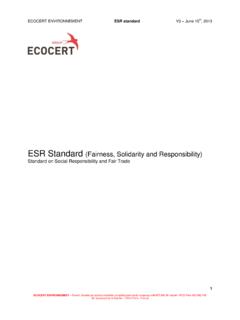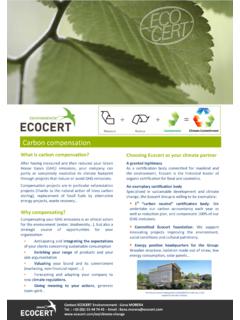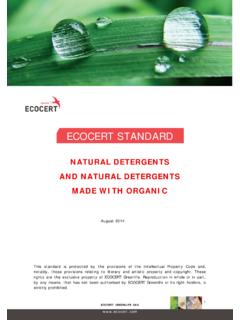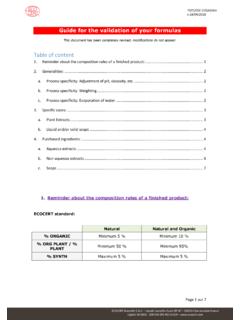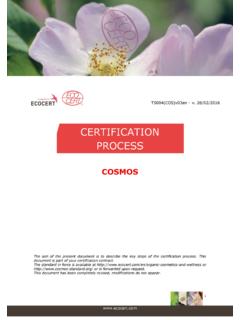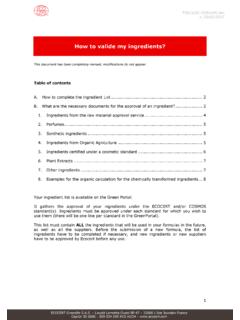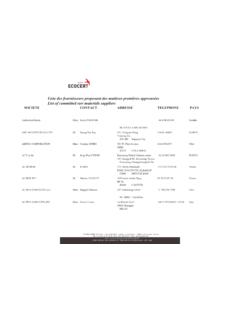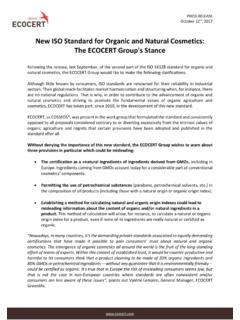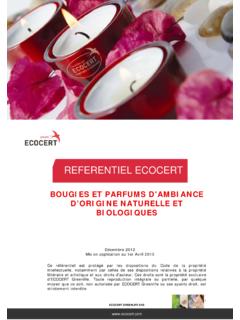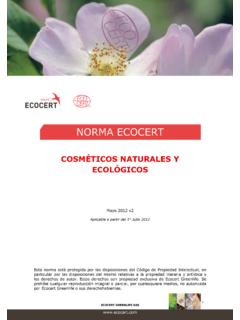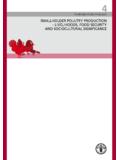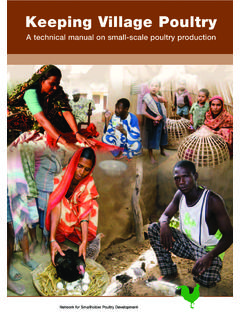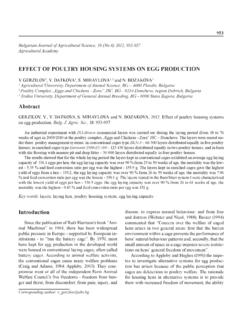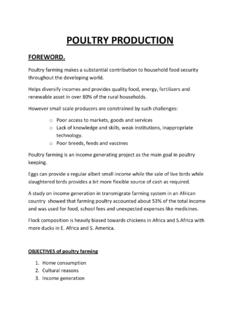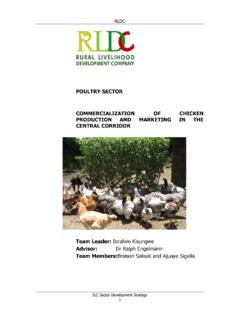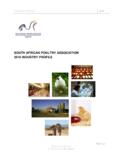Transcription of ORGANIC POULTRY FARMING - Ecocert
1 TS23 (EC)v02en_Poultry breeding 1 TS23 (EC)v02en_Poultry breeding 06/07/2012 Guidelines no. 23: Rules for ORGANIC POULTRY production in accordance with EU Regulation (EC) and (EC) ORGANIC POULTRY FARMING TS23 (EC)v02en_Poultry breeding 2 I. Scope The POULTRY species covered by European Regulation are listed in Annex III of (EC) Regulation 889/08: Laying hens Fattening POULTRY : chicken (broiler), guinea fowl, goose, duck and turkey Species which are not covered by European Regulation may be awarded ORGANIC certification if recognised national or private rules exist in the Member States.
2 In France, for example, this applies to ostriches. II. Conversion A. Definition The conversion to ORGANIC FARMING corresponds to the transition phase between conventional agriculture and the ORGANIC FARMING designation. The conversion period starts once : All the breeding requirements stated in (EC) Regulation 834/07 ( and 14) and (EC) Regulation 889/08 (arts. 8 to 25) are met (housing, feeding, disease ). The operator has submitted his holding to the control system and notified his ORGANIC activity to his competent authority.
3 Conversion period Runs 12 months or 6 months (with no other possible reduction) if the land concerned has not received disallowed treatments during the last year Fattening POULTRY 10 weeks Laying hens 6 weeks NB: Refer to chapter V. Purchasing animals on requirements for introducing non- ORGANIC animals into the holding. B. Examples of conversion NB: Animals may be wholly fed on in-conversion feedingstuffs (meaning starting from the 12th month of conversion of the land used to produce the feed) if the feed originates solely from the holding.
4 TS23 (EC)v02en_Poultry breeding 3 Non-simultaneous conversion: 12-month pasture conversion: Start of runs conversion Start of conversion for animals C1 ORGANIC 01/05/2010 01/05/2011 6 or 10 -week conversion for POULTRY Pasture conversion reduced to 6 months: Start of runs conversion Start of conversion for animals C1 ORGANIC 01/05/10 01/11/10 6 or 10 -week conversion for POULTRY Note: Simultaneous conversion of land and animals over 24 months is not economically beneficial in POULTRY production , when compared with non-simultaneous conversion.
5 III. Mixed operations A. Definition: Mixed operations means that one or several types of animal are reared simultaneously on the same holding, organically and conventionally. This duplication may be temporarily tolerated under specific conditions or prohibited in some cases. TS23 (EC)v02en_Poultry breeding 4 B. General rules: A single animal species may not be reared organically and conventionally simultaneously on the same farm (even if the ORGANIC and conventional units are completely separate).
6 Special cases Conditions Possible diversity of different species Clear separation of buildings and runs Example : ORGANIC chickens and conventional guinea fowl Holdings carrying out agricultural research or formal education : rearing the same species organically and conventionally Possibly subject to prior agreement of project by Ecocert IV. Identification and transport A. Identification documents POULTRY must be identified individually or by batch. Livestock records should be kept at all times, be made available to the control body and include the following details: animals entries (origin, number, conversion period, veterinary history, identification marks) animals leaving (age, number, destination, identification mark) any animal losses and the causes thereof feeding disease prevention, treatment and veterinary care B.
7 Transporting animals Animal transportation time should be reduced to limit stress and maintain their welfare conditions. Identification of the animals and their products must be ensured at all stages of production , preparation (slaughter, cutting up), transport and marketing. The use of allopathic tranquilisers before and during transportation is prohibited. TS23 (EC)v02en_Poultry breeding 5 V. Purchasing animals A. General remarks On an ORGANIC holding, purchased animals must be ORGANIC . Purchasing non- ORGANIC animals may, however, be authorised where the quantity of ORGANIC animals is inadequate.
8 B. Use of non- ORGANIC POULTRY Fattening POULTRY Conventional chicks introduced to constitute a flock or for renewal if they are less than 3 days old Laying hens Conventional chicks introduced to constitute a flock or for renewal if they are less than 3 days old Until 31 December 2014 : non- ORGANIC pullets under 18 weeks of age which have been fed and cared for in accordance with ORGANIC production methods may be introduced (Certificate issued by a certification body at the time of introduction of the pullets should be kept) C.
9 Exceptional conditions When animal mortality is high due to illness or catastrophic circumstances, the competent authority may authorise, with documentary evidence, flock renewal or re-establishment with non- ORGANIC animals on a temporary basis when organically reared animals are not available. (Art 47 RCE 889/08). TS23 (EC)v02en_Poultry breeding 6 VI. Feeding A. Feed materials of agricultural origin Feedstuff self- production At least 20% of the feed shall be self-produced by the farm or be produced in the same region in cooperation with other ORGANIC farms or feed business operators (same administrative region or closest administrative regions).
10 Origin Conditions Options ORGANIC FEEDSTUFFS Plant origin Any type of plant No conditions Animal origin Any feed material of animal origin in compliance with standard regulation FEEDSTUFF NOT FROM ORGANIC FARMING Non- ORGANIC Spices, herbs and molasses Protein feed of plant and animal origin Yeasts Saccharomyces cerevisiae and/or carlsbergiensis Products from sustainable fisheries -if non available in ORGANIC form -produced or prepared without chemical solvents -1% /year maximum of the feed ration (calculation as a % of dry matter of feed from agricultural origin) -if non available in ORGANIC form -produced or prepared without chemical solvents -5% maximum per period of 12 months (calculation as a % of dry matter of feed from agricultural origin)
